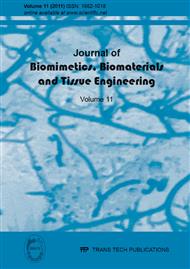p.1
p.13
p.21
p.35
p.45
p.67
p.73
p.81
p.93
A Theoretical Model to Fracture in Cell Membrane
Abstract:
A new stress function modelling the fails in biological tissue is here proposed. Under the assumption that the cell membrane may be modelled as neo-Hookean materials, we develop the problem in the framework of non-linear elasticity. We attempt to model the ice nucleation phenomenon when freezing and thawing occurs in cellular cryo-preservation. The ice seed generated surface can be either soft or wrinkled and, when the latter emerges a punch contact against the cell membrane takes place. Restricting our attention on opportune mono-dimensional sub-set, we extend the multiple critical points theorem at our model. We find a particular solution in agreement to the classical fracture models besides a response function in accordance to the stress and strain field distribution in biological materials.
Info:
Periodical:
Pages:
67-71
Citation:
Online since:
September 2011
Authors:
Price:
Сopyright:
© 2011 Trans Tech Publications Ltd. All Rights Reserved
Share:
Citation:


